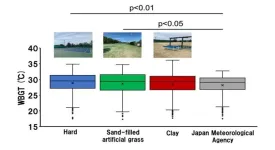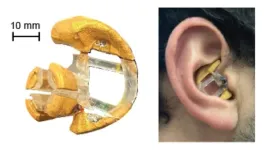(Press-News.org) Mom always said, “Choose your friends wisely.” Now a study led by a Rutgers Health professor shows she was onto something: Their traits can rub off on you – especially ones that are in their genes.
The genetic makeup of adolescent peers may have long-term consequences for individual risk of drug and alcohol use disorders, depression and anxiety, the groundbreaking study has found.
“Peers’ genetic predispositions for psychiatric and substance use disorders are associated with an individual's own risk of developing the same disorders in young adulthood,” said Jessica E. Salvatore, an associate professor of psychiatry at the Rutgers Robert Wood Johnson Medical School and lead author of the study published in the American Journal of Psychiatry. “What our data exemplifies is the long reach of social genetic effects,” Salvatore said.
Socio-genomics – the influence of one person’s genotype on the observable traits of another – is an emerging field of genomics. Research suggests that peers’ genetic makeup may influence health outcomes of their friends. To test this, Salvatore and colleagues used Swedish national data to assess peer social genetic effects for several psychiatric disorders.
With an anonymized database of more than 1.5 million individuals born in Sweden between 1980 and 1998 to Swedish-born parents, the first step was to map individuals by location and by school during their teenage years. The researchers then used medical, pharmacy and legal registries documenting substance use and mental health disorders for the same individuals in adulthood.
Models were run to assess whether peers’ genetic predispositions predicted target individuals’ likelihood of experiencing substance abuse, major depression, and anxiety disorder in adulthood. Peers’ genetic predispositions were indexed with family genetic risk scores – personalized measures of genetic risk based on family history – for the same conditions.
Even when controlling for factors such as the target individuals’ own genetic predispositions and family socioeconomic factors, the researchers found a clear association between peers’ genetic predispositions and target individuals’ likelihood of developing a substance use or psychiatric disorder. The effects were stronger among school-based peers than geographically defined peers.
Within school groups, the strongest effects were among upper secondary school classmates, particularly those in the same vocational or college-preparatory track between ages 16 and 19. Social genetic effects for school-based peers were greater for drug and alcohol use disorders than major depression and anxiety disorder.
Salvatore said more research is needed to understand why these connections exist.
“The most obvious explanation for why peers’ genetic predispositions might be associated with our own well-being is the idea our peers’ genetic predispositions influence their phenotype, or the likelihood that peers are also affected by the disorder,” she said. “But in our analysis, we found that peers’ genetic predispositions were associated with target individuals’ likelihood of disorder even after we statistically controlled for whether peers were affected or unaffected.”
What is clear, Salvatore said, is what the findings mean for interventions.
“If we want to think about how to best address these socially costly disorders, we need to think more about network based and social interventions,” she said. “It’s not enough to think about individual risk.”
This research also underscores the importance of disrupting processes and risks that extend for at least a decade after attendance in school, Salvatore added. “Peer genetic influences have a very long reach,” she said.
Coauthors include Henrik Ohlsson, Jan Sundquist and Kristina Sundquist, from Lund University in Sweden; and Kenneth S. Kendler from the Virginia Institute for Psychiatric and Behavioral Genetics at Virginia Commonwealth University.
END
Your best friend from high school? Here’s why their genes mattered
Peer social genetic effects – the influence of a social partner’s genotype on the observable traits of another – influence risk for addiction and psychiatric disorders later in life, a Rutgers study finds
2024-08-07
ELSE PRESS RELEASES FROM THIS DATE:
How does an effective cancer therapy damage the heart?
2024-08-07
Cytotoxic T-lymphocyte antigen 4 (CTLA-4) is a protein receptor on T immune cells that prevents the cells from killing other cells, such as cancer cells. Blocking CTLA-4 with a specific antibody is an effective treatment for some cancers, but it can damage the heart. New research published in The FASEB Journal reveals the mechanisms involved in this side effect—a finding that could be used to help prevent it.
Experiments conducted in mice showed that blocking CTLA-4 activates certain T cells called Th17 cells, which increase inflammation. Inhibiting this activation reversed ...
How well will different US forests remove atmospheric carbon in the future?
2024-08-07
Forests absorb carbon by capturing carbon dioxide from the atmosphere, making forest carbon stocks an important resource against climate change. In research published in Ecology and Evolution, investigators examined existing tree regeneration patterns to develop an indicator of potential changes to future carbon stocks across forests in the northeastern and midwestern United States.
The scientists’ comparison of carbon stock predictions from tree and seedling composition suggested that 29% of plots were poised ...
Medical issues experienced by women and children after returning from Hamas captivity
2024-08-07
Among the 250 individuals who were kidnapped during the Hamas terror attack on Israeli towns in October 2023, 19 children and 7 women were released and admitted to Schneider Children's Medical Center of Israel after approximately 50 days in captivity, during a cease-fire deal. A new study published in Acta Paediatrica reports on the physical and psychological state of these returnees upon their return.
The most common clinical findings included significant weight loss, psychological trauma, complications of poor hygiene (such as head lice), and complications of recent shrapnel injuries. Tests revealed that returnees also often had ...
Do dieticians have weight biases towards themselves and others?
2024-08-07
In a survey-based study, UK dietitians exhibited significant weight stigma, both towards themselves and towards others.
The study in the Journal of Human Nutrition and Dietetics involved an online survey completed in 2022 by 402 registered dietitians aged 20–70 years old. Most respondents reported personally experiencing weight stigma prior to (51%) and after becoming (59.7%) registered dieticians, and nearly a quarter (21.1%) felt that their weight influenced their own ability to perform as a dietitian.
Weight stigma was experienced across the weight spectrum. Participants reported explicit (or conscious) weight bias attitudes, moderate beliefs that obesity is ...
Can nanomaterials enhance plant tolerance to high soil salt levels?
2024-08-07
Soil salt concentrations above the optimal threshold for plant growth can threaten global food security by compromising agricultural productivity and crop quality. An analysis published in Physiologia Plantarum examined the potential of nanomaterials—which have emerged over the past decade as a promising tool to mitigate such “salinity stress”—to address this challenge.
Nanomaterials, which are tiny natural or synthetic materials, can modulate a plant’s response to salinity stress ...
Study on planet-warming contrails “a spanner in the works” for aviation industry
2024-08-07
Modern commercial aircraft flying at high altitudes create longer-lived planet-warming contrails than older aircraft, a new study has found.
The result means that although modern planes emit less carbon than older aircraft, they may be contributing more to climate change through contrails.
Led by scientists at Imperial College London, the study highlights the immense challenges the aviation industry faces to reduce its impact on the climate. The new study also found that private jets produce more contrails than previously thought, ...
Sea lion camera crews help researchers explore previously unmapped ocean habitats
2024-08-07
The world’s seabeds are little explored, and the knowledge we have is patchy. Using remotely operated underwater vehicles to learn about seabeds is expensive, requires certain weather conditions, and is difficult in deep, remote, and offshore habitats.
To circumvent these challenges, researchers in Australia have now enlisted endangered Australian sea lions (Neophoca cinerea) to carry cameras. The resulting videos allowed the researchers to identify previously unmapped benthic habitats used by the sea lions on the continental shelf. They published their results in Frontiers in Marine Science.
“Using ...
Superbugs spread to family members of recently hospitalized patients
2024-08-07
ARLINGTON, Va. (August 7, 2024) — Family members of patients recently discharged from the hospital may have a higher risk of getting an antibiotic-resistant infection, often called a superbug, even if the patient was not diagnosed with the same infection, suggesting hospitals play a role in the community spread of resistant bacteria, according to study in Infection Control & Hospital Epidemiology, the journal of the Society for Healthcare Epidemiology of America.
When recently hospitalized patients were diagnosed with the superbug — Methicillin-resistant ...
Preventing heat stroke in tennis: insights into the heat environments of tennis courts
2024-08-07
With rising global temperatures due to global warming, the risk of heat strokes has increased and is expected to grow even further. This is particularly troubling for athletes participating in competitive sports. In tennis, multiple matches are played daily, lasting up to five hours. Playing such matches in sweltering conditions could be highly detrimental.
The Tokyo Olympic Games in 2021 faced extremely hot conditions with many players calling for appropriate countermeasures. Consequently, the International Tennis Federation (ITF) formulated and issued the “Extreme Weather Policy” at the Tokyo Olympics to manage matches based ...
Dozing at the wheel? Not with these fatigue-detecting earbuds
2024-08-07
Everyone gets sleepy at work from time to time, especially after a big lunch. But for people whose jobs involve driving or working with heavy machinery, drowsiness can be extremely dangerous — if not outright deadly. Drowsy driving contributes to hundreds of fatal vehicle accidents in the U.S. each year, and the National Safety Council has cited drowsiness as a critical hazard in construction and mining.
To help protect drivers and machine operators from the dangers of drifting off, engineers at the University of California, Berkeley, have created prototype earbuds that can detect the signs of drowsiness ...
LAST 30 PRESS RELEASES:
Decades of suffering: Long-term mental health outcomes of Kurdish chemical gas attacks
Interactional dynamics of self-assessment and advice in peer reflection on microteaching
When aging affects the young: Revealing the weight of caregiving on teenagers
Can Canada’s health systems handle increased demand during FIFA World Cup?
Autistic and non-autistic faces may “speak a different language” when expressing emotion
No clear evidence that cannabis-based medicines relieve chronic nerve pain
Pioneering second-order nonlinear vibrational nanoscopy for interfacial molecular systems beyond the diffraction limit
Bottleneck in hydrogen distribution jeopardises billions in clean energy
Lung cancer death rates among women in Europe are finally levelling off
Scientists trace microplastics in fertilizer from fields to the beach
The Lancet Obstetrics, Gynecology, & Women’s Health: Taking paracetamol during pregnancy does not increase risk of autism, ADHD or intellectual disabilities, confirms new gold-standard evidence review
Taking paracetamol during pregnancy does not increase risk of autism, ADHD or intellectual disabilities
Harm reduction vending machines in New York State expand access to overdose treatment and drug test strips, UB studies confirm
University of Phoenix releases white paper on Credit for Prior Learning as a catalyst for internal mobility and retention
Canada losing track of salmon health as climate and industrial threats mount
Molecular sieve-confined Pt-FeOx catalysts achieve highly efficient reversible hydrogen cycle of methylcyclohexane-toluene
Investment in farm productivity tools key to reducing greenhouse gas
New review highlights electrochemical pathways to recover uranium from wastewater and seawater
Hidden pollutants in shale gas development raise environmental concerns, new review finds
Discarded cigarette butts transformed into high performance energy storage materials
Researchers highlight role of alternative RNA splicing in schizophrenia
NTU Singapore scientists find new way to disarm antibiotic-resistant bacteria and restore healing in chronic wounds
Research suggests nationwide racial bias in media reporting on gun violence
Revealing the cell’s nanocourier at work
Health impacts of nursing home staffing
Public views about opioid overdose and people with opioid use disorder
Age-related changes in sperm DNA may play a role in autism risk
Ambitious model fails to explain near-death experiences, experts say
Multifaceted effects of inward foreign direct investment on new venture creation
Exploring mutations that spontaneously switch on a key brain cell receptor
[Press-News.org] Your best friend from high school? Here’s why their genes matteredPeer social genetic effects – the influence of a social partner’s genotype on the observable traits of another – influence risk for addiction and psychiatric disorders later in life, a Rutgers study finds


